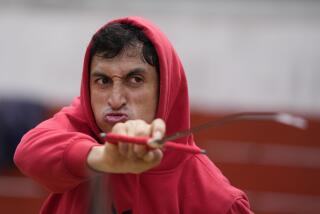Bullfighting Is Losing Its Aficionados
- Share via
MADRID — The crowd at Madrid’s Las Ventas bullring jeered in protest as yet another overweight black bull wandered around the sand ignoring the matador’s attempts to goad him into fighting.
“The fiesta is a fraud,” muttered one cigar-puffing aficionado.
“Get off!” shouted another, adding a sarcastic “Ole!” as the matador swished his cape over the sluggish bull.
To the horror of animal lovers, bullfighting is enjoying a new golden age. It drew a record 54 million spectators last year.
But some fans fear that the success of the fiesta has taken the fire out of the bulls, making a mockery of a spectacle that they believe should be a deadly serious affair.
“Of all the bulls I have seen so far this season, only one or two have been acceptable,” said a veteran fan watching a recent corrida (bullfight) at the end of the 26-day San Isidro festival in Madrid, the top event in the bullfighting calendar.
As the hot evening sun slid slowly behind the Moorish-style walls of Las Ventas, the Mecca of the bullfighting world, bull after bull stumbled in half-hearted charges and the agitated crowd waved green handkerchiefs to demand replacements.
“There is an epidemic in Las Ventas,” grumbled the culture pages of El Pais newspaper. “There must be an epidemic, or how else can you explain so many sickly bulls, so many stumbles. . . . “
To the untrained eye, the magnificent half-ton bulls all look awesome, but the most seasoned aficionados quickly spot the slightest limp or visual defect.
“That one’s cross-eyed, look at the way he charges,” said the cigar smoker.
Complaints about bulls are nothing new. Bullfighting fan Ernest Hemingway moaned about them in his “Death in the Afternoon” of 1932.
But bullfighting critic Paco Aguado, whose job is more akin to a theater critic than a sports commentator, said that two decades of slow recovery and the current boom had brought the fiesta to a crisis of quality.
“The fiesta has become very mass-produced and there are now 700 corridas a year, so it has become a matter of quantity not quality,” he said.
Las Ventas during the San Isidro fiesta is the fashionable place to be seen, but the undiscerning eyes of the fad-followers in seats high up in the arena prefer bulls that look big.
“The rest of Spain wants bulls in their rings like the ones they see in Madrid on the television,” said Aguado. “The taste for overweight bulls is spreading, and smaller but fiercer breeds are disappearing.
“If you put an extra 150 kilograms (330 pounds) on (Canadian athlete) Ben Johnson, he would not be able to run very fast.”
Each bull is worth nearly $10,000, and bulls from top breeders can double or triple in price. Breeders who used to raise bulls as a hobby now take the business very seriously and do not want animals rejected.
Jaime Erize, president of the Union of Bull Breeders, said breeders have to produce the bulls the ring owners demand. He blamed the decline in quality on the public.
In two decades, he said, the average bull has swollen from around 1,058 pounds--a weight at which they can combine force with agility--to a portly 1,235 pounds.
More to Read
Sign up for Essential California
The most important California stories and recommendations in your inbox every morning.
You may occasionally receive promotional content from the Los Angeles Times.












